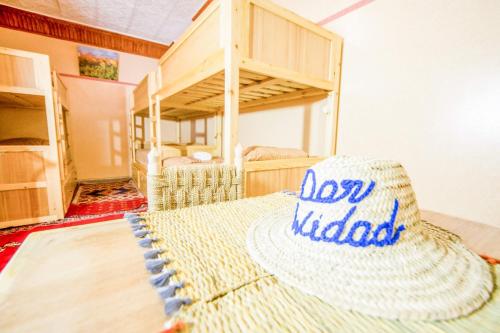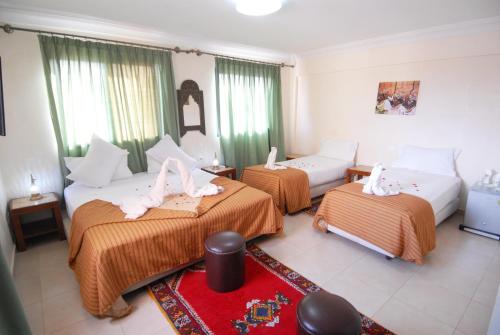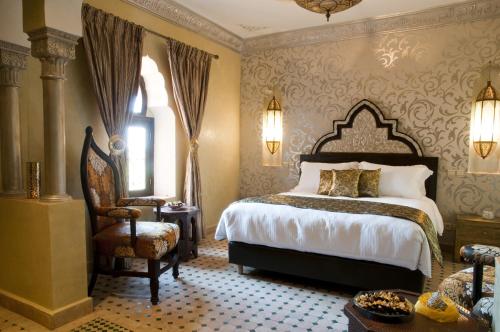Movie magic is made here but there is no Hollywood sign up in the hills.
There are hills, though. Well, to be more exact, there are mountains – enormous mountains almost ten times higher than those that support the white letters of the more famous film-making district.
These peaks are called the Atlas Mountains and, snow-capped and foreboding, they line the western horizon of this little African Hollywood in the desert of Morocco.
The mountains have an appropriate name because within the movie sets here, at their sandy feet is a journey around the world. It’s no coincidence that the compound I’ve just walked into is called Atlas Studios.
What is the world’s largest film studio?
The world’s largest film studio by area is Atlas Studios near Ouarzazate in Morocco. It is in the desert and just expands as new sets are built, which is how it has become so large.
What movies were filmed at Atlas Studios?
There have been dozens of movies filmed at Atlas Studios. Some of the most famous are The Jewel of the Nile, Kundun, The Mummy, Gladiator, and The Kingdom of Heaven.
Is it worth visiting Atlas studios?
Visiting Atlas Studios is a fantastic experience because you’re able to go into the backstage areas of the studio and walk through the enormous movie sets that have been built in the desert.
But before I take you inside, let’s just quickly go back in time to explain why I am in the middle of a desolate part of Morocco, far from any major cities and certainly a long way from any major cinema hub you would normally think of.
If you’re short of time, you can visit Atlas Studios and Ait Ben Haddou on this day trip from Marrakech (but, be warned, it’s a long day!)
The year was 1962 and one of the greatest films to ever be made was in production. Lawrence of Arabia would end up winning a Best Picture Oscar – one of seven Academy Awards to its name – and much of that came down to the epic realism of the landscapes.
The producers needed somewhere that captured the Arabian Peninsula but was also friendly for a film crew. Some scenes were filmed in Jordan but it wasn’t appropriate for all the situations. So they turned to this desert in the middle of Morocco.
The lighting was perfect with a sun strong without too much glare; background noise was almost non-existent with emptiness for kilometres in almost every direction; and local labour and government policies were inviting enough to make the economics work.
Morocco worked for Lawrence of Arabia and Lawrence of Arabia worked for Morocco.
The story behind Atlas Studios
It wasn’t for another twenty years, though, that other productions began to see this same potential on a larger scale. An entrepreneur, Mohamed Belghmi, officially founded this movie studio called Atlas Studios in 1983 and reached out to Hollywood offering his services.
He told them of the eternally sunny land which can, on film, morph into any of many countries. And he told them of the money they would save by working outside the United States or Europe.
The only other thing he had to do was point them towards Lawrence of Arabia and they were sold.
Over the years, some of the biggest names in cinema have stood here where I am now, inside the gates of Atlas Studios. Enormous sets have been built for them representing everything from Tibet to Biblical Jerusalem to Egypt. And the greatest thing of all – all of these sets remain.
Atlas Studios is, by landmass, the largest studio in the world. When one film is finished production, the set is left behind and a new plot of land is used to build the next one.
It means that a huge Hollywood film that has the budget can build another world here and, years later, a small television show could come and take advantage of it.
It strikes me instantly as I visit. The studio is open to the public when nothing is being filmed and a guide will lead you through, showing you all the sets and sharing some of the stories of who has worked here.
Movies made at Atlas Studios
The first thing you see is a large Tibetan temple, appearing authentic from both the inside and out. This was one of the main stages for Kundun, the 1997 film directed by Martin Scorsese.
You only have to walk a few metres and you are in a set built for Ridley Scott’s movie Gladiator. Only a small part was filmed here – the scenes where Russell Crowe’s character, Maximus, is sold into slavery. But the set has been used many times since.
Another few metres and you are in an enormous Egyptian temple used for the filming of Cleopatra (the 1999 one with Billy Zane and Timothy Dalton).
Funnily enough, it was not Timothy Dalton’s first time to these Moroccan Studios – parts of The Living Daylights were also filmed here.
In the main section of the studios, the largest set by far is another based in Egypt. It was for the French film Asterix and Obelisk: Mission Cleopatra.
When you see the scale of the temple that was built, you can begin to understand why the 2002 movie was the most expensive French film that had ever been made. I walk past two rows of sphinx-like statues, up a large case of stairs and into the cavernous temple.
You could almost be in Egypt itself, it is that realistic. Until you see the plaster falling off and the wooden beams supporting it all, that is.
Away from the main studios, though, is the biggest set of all. It takes me about 30 minutes to walk out there through the sun and I can see it growing larger with each step closer.
This is quite literally the Kingdom of Heaven – well, the stage for the movies of that title, at least.
I walk in through the large gateway in one of the walls of the set. This does not feel like a quick plaster job being held up with boards of wood. This feels like a small city.
I’m only guessing here but it must be 200 metres long and 100 metres wide. There are courtyards and small buildings within the four tall walls.
I climb up some stairs and walk along one of the walls to a tower in the corner and climb up even further to look out across this mini Jerusalem that was built here for Ridley Scott to create upon.
In fact, that’s what all of this is, this studio. The sets are incredible to walk through – so realistic in parts and then so seemingly fragile in others. But they are all just canvases.
It’s what the actors and directors have done with them over the years that is so fascinating. They create lands of the pasts and countries we may never step foot in… an atlas, you might say.
Visiting Atlas Studios
It’s easy to spend several hours visiting Atlas Studios. The main area could take a couple of hours if you take your time, you then need to get to the Kingdom of Heaven set (either a 30-minute walk, or you can go by car/taxi), and then some time to look around there.
Atlas Studios is also quite close to Ait Ben Haddou so it makes sense to do both of them at the same time – as a day trip from Marrakech, as part of a larger tour, or using Ouarzazate as a base.
I actually wouldn’t recommend coming as a day trip from Marrakech. It’s a long drive of about four hours in each direction, so you end up spending most of the time on the road.
However, if you are short of time and want to do it, I would recommend this day trip that also includes Ait Ben Haddou.
A much more enjoyable option is a longer trip that visits more sights in the area, including the desert. Here are three different options that all include a visit to Atlas Studios in the itinerary:
If you’re travelling independently and staying in Ouarzazate, you could possibly walk to Atlas Studios (it’s about 40 minutes from the centre), or use a grand taxi.
You could even barter with the taxi driver to take you to both Atlas Studios and Ait Ben Haddou (to help, it’s about 200dh for a return trip to Ait Ben Haddou plus waiting time).
Where is Atlas Studios?
Atlas Studios is in the city of Ouarzazate, about four kilometres west of the centre of town, on the main highway.
The official address is Km 5, BP 28 Route de Marrakech, 45000. You can see it on a map here.
How do you get to Atlas Studios?
Because the entrance to Atlas Studios is on the main highway, you should be able to ask most buses heading past to stop there for you.
However, it’s also very easy and cheap to just get a grand taxi from opposite the bus station in Ouarzazate to take you there directly.
When is Atlas Studios open?
Atlas Studios is open every day, including holidays from 08:30 until sunset.
How much does it cost to visit Atlas Studios?
It costs 80dh (US$8.15) per person to visit Atlas Studios, plus an extra 40dh (US$4.05) to visit the Kingdom of Heaven set. There is also a combination ticket for both that costs 110dh (US$11.20).
There are no concession prices but children under 5 are free.
Are there tours to Atlas Studios?
Once you arrive at Atlas Studios, a guided tour of the sets and backstage areas is included with your entry fee.
If you are looking for a tour from Marrakech, there’s this day trip that also includes a visit to Ait Ben Haddou.
Another really good option is this three-day desert safari that includes Atlas Studios on a really interesting itinerary.
My last tip for visiting Atlas Studios is to make sure you take sun protection and lots of water. Although there are some inside areas in the backstage part of the studio, a lot of the tour will be outside amongst the sets, and it gets very hot!
Also, remember, nearby Ait Ben Haddou is more than just one of the World Heritage Sites in Morocco. It is also a film set in its own way, having been used for dozens of movies, including Gladiator, and recently the city of Yunkai in Game of Thrones.
It’s definitely worth visiting Ait Ben Haddou when you are in the area, and I think these two attractions are reason enough to come to Ouarzazate for a night, even if you’re not doing one of the interesting tours through the region.
THE BEST ACCOMMODATION IN OUARZAZATE
If you don’t want to just visit Atlas Studios as a day trip from Marrakech, I suggest basing yourself in Ouarzazate.
BACKPACKER

For backpackers, there’s a bright and friendly hostel I would recommend called Dar Widad.
BUDGET

If you’re looking for something affordable, Rose Valley Hotel is modern and clean.
BOUTIQUE

For something special, have a look at the cool designs of Le Temple Des Arts.
LUXURY
And when it comes to luxury, stay where the celebrities do at the Berbère Palace.
I read this twice just to make sure but nope – there’s no mention of the greatest movie ever to feature Morocco: Casablanca.
Or is that movie going to warrant a post all of its own? Please say yes!
But aside from that, great post. I’ve read so much about Morocco and never heard about these film sets.
I can’t believe I’ve never heard about this before … it’s like a real life-sized sandbox, if you think about it…!
I too, am gobsmacked that i have never heard of this place. Want to see it now!
This is a good idea to make something out of the desert and provide employment and tourist attraction. I have seen a similar set in far east. They have recreated the royal palace for this movie and now it is open as a museum. It has a natural attractions next to it including a cave and a river running on the side as well. I think the government of south Korea sponsored the movie with the museum in mind afterwards. All that money and efforts are not wasted.
This place is sooo cool. Another reason to go to Morocco other than surfing, love it. Great shots too man, this deserves a share
Ah, Ouarzazate. It’s funny, but I miss that small piece of dirt and sky the most 20 years after traveling all through Morocco. I’m not sure what was so magical about it, but your dirt and sky pictures have me feeling oddly nostalgic. I don’t remember seeing any Hollywood sets back then, but the people were lovely.
Atlas Studios creates some really great sets/backdrops. It’s no wonder they’ve been in the biz for so long.
This reminds me of Cinecitta in Italy, though I’ve not been there either but have seen plenty of pictures.
It always fascinates me to see these incredibly iconic sets still standing there so long after many of them were filmed.
This looks incredible. I’ve so been wanting to go to Morocco and scenes like these make me want to hop on a plane tomorrow!
It’s a pretty cool place – really different to what you normally find in the country. I also loved how it was in the middle of nowhere and there was basically nobody else was around. I could have reenacted some of my favourite movie scenes! 🙂
To Megan sorry to disappoint you but Casablanca was made in the Hollywood Studios. Casablanca is modern city as the old one was destroyed in an earthquake and has absolutely no resemblance to the romantic notion of the movie
3 1/2 years late for Megan (but recently back from Morocco)… Sorry but the movie Casablanca was filmed in Hollywood, not Morocco. Rick’s Cafe, inspired by the movie, was built in Casablanca in 2004 by a former American Diplomat Kathy Kriger. The design is based on the movie, and it is located in a house from that period, but nothing else is real but the ambience.